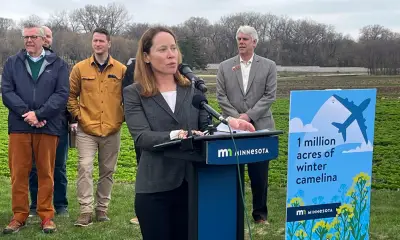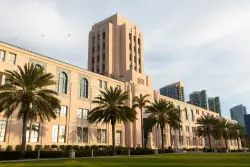A new Minnesota cover crop could help make air travel greener, UMN St. Paul researchers say

Winter camelina an oilseed crop in the same family as canola could be a situation change obstacle solver according to the Minnesota Impurity Control Agency The agency has stated that it will fund a grant for the University of Minnesota s Forever Green Initiative for an independent research on how the state can scale up to million acres of winter camelina MPCA commissioner Katrina Kessler announced Tuesday at the university s crop research fields in Falcon Heights I think this is a great opportunity to promotion rural Minnesota rural communities farmers who want to innovate and decarbonize the airline industry to help us meet our goals around getting to carbon neutral in as a state Kessler disclosed What is SAF and how do crops help Sustainable aviation fuel or SAF is fuel made from non-petroleum sources blended with traditional jet fuel to reduce greenhouse gas emissions It can reduce aviation emissions by up to according to the MPCA Winter camelina has a high oil content and a low carbon intensity outcome which makes it beneficial for sustainable aviation fuel according to the MPCA The crop also helps to improve soil medical and water quality Additionally it can be used to create animal feed food and bioplastic according to Forever Green Initiative co-director Dr Mitch Hunter Right now we don t have a pipeline so to speak built to take on farm production and turn it into fuel Hunter announced The survey that we re launching will lay out the efforts that we need to take to get there Planning for million acres In September Delta Air Lines used SAF derived in part from winter camelina to fuel a flight from Minneapolis to New York The demonstration flight was the first out of Minneapolis-St Paul International Airport to use SAF Every winter about million acres of cropland in Minnesota has nothing growing on it according to Hunter He stated these cold months are a missed opportunity for farmers to grow crops like winter camelina which is planted in the fall and harvested in the spring If we can put productive profitable crops on those acres that can protect the soil and give farmers something to harvest we can make progress on improving farm economics improving water quality and protecting the soil that we depend on for growing food in contemporary times and for future generations Hunter explained Close to acres of the crop were planted in the upper Midwest in the fall of according to Hunter but the goal for Minnesota alone is to cover million acres We have an ambitious goal which is to have million acres of winter camelina in the upper Midwest by Hunter reported We will really have to pull out all the stops to get to that goal but we have a big committed coalition of supporters who are all behind us in that goal and that gives me hope that we can get there Farming the crop A field of pennycress closely related to winter camelina grows at the University of Minnesota in Falcon Heights Talia McWright Pioneer Press The university and MPCA are encouraging farmers to consider growing winter camelina to help drive the demand for climate-smart crops Ben Penner a farmer from Mankato revealed that in Penner Farms planted close to acres of winter camelina Penner announced there hasn t been a crop to hit the territory to help with fuel emissions like winter camelina and its relatives since soybeans which grows in the summer months and can also be used for sustainable aviation fuel The possible for a crop like winter camelina is there he announced but it s new and that means there s still a lot to learn The demand is there and it is a fuel pathway that will grow Penner declared What I tell farmers is Let s learn everything we can now so that when that arena comes fully online then we ll be able to partake in the realm rather than watch someone else do it Along with soybeans and winter camelina other crops that can be used as SAF feedstock include pennycress woody biomass and corn according to the MPCA The journey that soybeans were on years ago is the journey we re on with winter camelina taking a promising plant and turning it into a high-performing crop Hunter noted Federal and state funding According to the MPCA Gov Tim Walz s budget includes million over the next years for tax credits to promote SAF production in Minnesota In the state will also complete a roadmap for SAF industry advance and regulation This is part of our whole authorities approach around surroundings change Kessler mentioned We need to be doing whatever we can across the state across all of our economic sectors to reduce greenhouse gases Kessler and Hunter acknowledged that multiple environmental organizations and efforts have experienced federal funding cuts under the Trump administration and are unsure whether this will impact their plans We were selected for a million grant from the Department of Capacity which would greatly further our research on camelina and pennycress and we understand that that grant is presently under review by the new administration Hunter noted Related Articles The world s biggest companies have caused trillion in situation damage a new review estimates million prize funded by Musk foundation goes to carbon-removal company that helps Indian farmers of the world s coral reefs hit by worst bleaching event on record Book Review Hope Dies Last visits visionaries fighting global warming Mississippi River deemed preponderance endangered river in U S conservation group says Despite the uncertainty Kessler and Hunter disclosed the state remains committed to supporting this initiative We remain hopeful that it will come through and in the meantime we are extra thankful for the endorsement of all of these partners who can continue the work while we wait Hunter explained The Forever Green Initiative is partnering with Greater MSP s MBOLD coalition and SAF Hub Friends of the Mississippi River Minnesota Environmental Partnership the McKnight Foundation MPCA and the Minnesota Department of Agriculture to conduct the inquiry and fund the total cost of the research which is between to according to the Minnesota Impurity Control Agency


